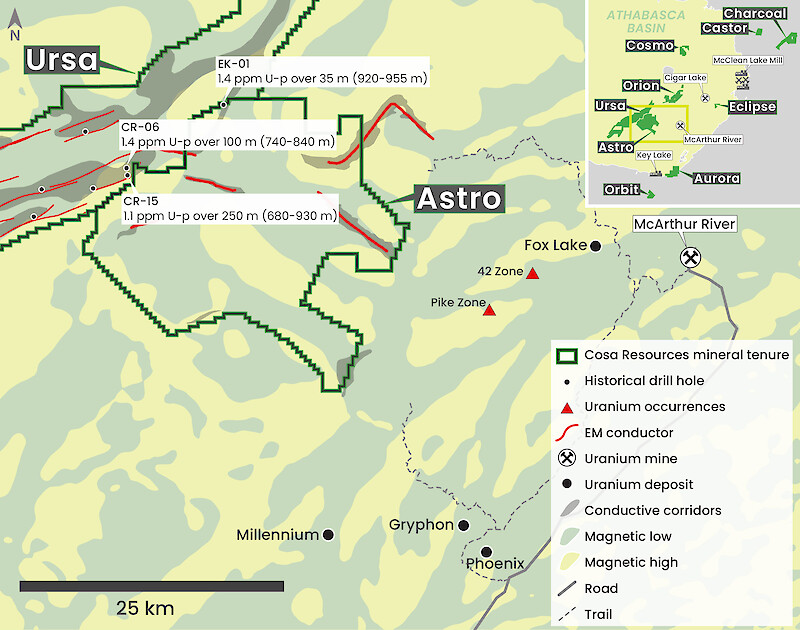In April 2025, the Company announced it had signed an Option Agreement to allow Global Uranium Corp (CSE: GURN) to earn up to 80% of the Astro Project over several phases outlined below.
| Exploration Expenditures | Cash Payments | Share Payments | Total Ownership | Deadline | |
| Signing | 100,000 | 0% | |||
| Phase 1 | $500,000 | $100,000 | 200,000 | 20% | 31 December 2025 |
| Phase 2 | $1,500,000 | $100,000 | 300,000 | 35% | 31 December 2026 |
| Phase 3 | $2,000,000 | $200,000 | 500,000 | 50% | 31 December 2027 |
| Phase 4 | $2,500,000 | $200,000 | 500,000 | 65% | 31 December 2028 |
| Phase 5 | $3,000,000 | $200,000 | 1,000,000 | 80% | 31 December 2029 |
| C$9,500,000 | C$800,000 | 2,600,000 |
The Astro Project is located roughly 28 kilometres west of Cameco’s McArthur River Mine, the world’s largest high-grade uranium mine, and approximately 10 kilometres west of CanAlaska Uranium Ltd.’s Pike Zone which boasts world-class intersections. Airborne geophysics completed in 2023 at Cosa’s neighboring Ursa project confirmed that untested conductive trends continue from Ursa onto the Astro Project. Additionally, over 20 kilometres of conductive strike has been identified by historical surveys at Astro, which has been tested by a single drill hole, EK-01. EK-01 failed to explain the strong conductive response it was targeting, suggesting the hole was not ideally located. However, the historical drill log notes favourable features in the sandstone including a brecciated and silicified interval in the upper portion, decametre-scale intervals of illite-dominated clay mineralogy throughout, and moderately bleached and slightly friable intervals in the lower 150 metres, features which are commonly associated with unconformity related uranium deposits of the Athabasca Basin including McArthur River, Cigar Lake, and Hurricane. Roughly 11 kilometres to the southwest of EK-01 and within 700 metres of the Astro Project, strongly anomalous uranium geochemistry and pervasive hydrothermal alteration was intersected in the lower to medial sandstone of historical drill holes CR-06 and CR-15. Drilling completed by Cosa in 2024 failed to explain the source of the geochemical anomaly however ground-based EM work completed by Cosa indicates that the targeted conductor likely trends onto the Astro Project.
Astro hosts over 40 kilometres of magnetic low strike that has been untested by drilling, the vast majority of which has not been covered by any modern EM survey. A patchwork of historical airborne and ground EM surveys covering a portion of the contained magnetic low strike length has defined that conductive trends are present within most surveyed areas. Notably, the Project is entirely unexplored for the extension of regional structures related to both the McArthur River and Fox Lake uranium deposits, located roughly 28 and 17 kilometres east of Astro, respectively. Cosa and Global Uranium will execute a work plan designed to rapidly and efficiently canvas much of the Astro Project for early identification of the most compelling and high-upside drill targets. The depth to the unconformity at Astro is estimated to be between 850 and 975 metres.

